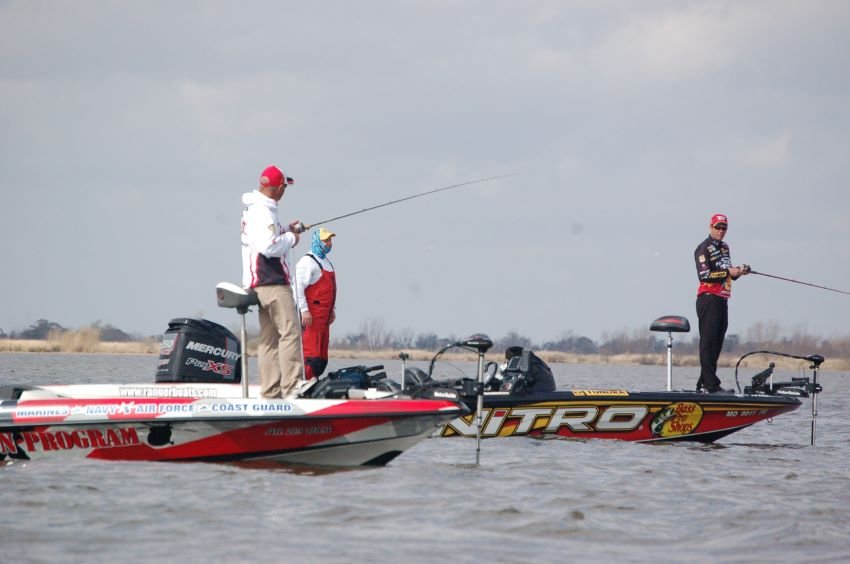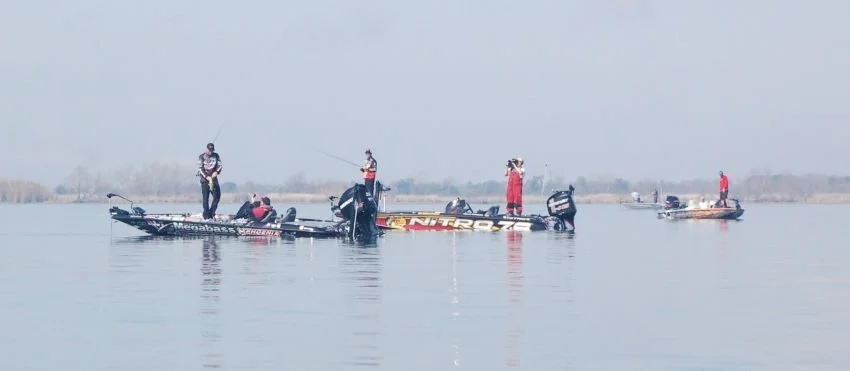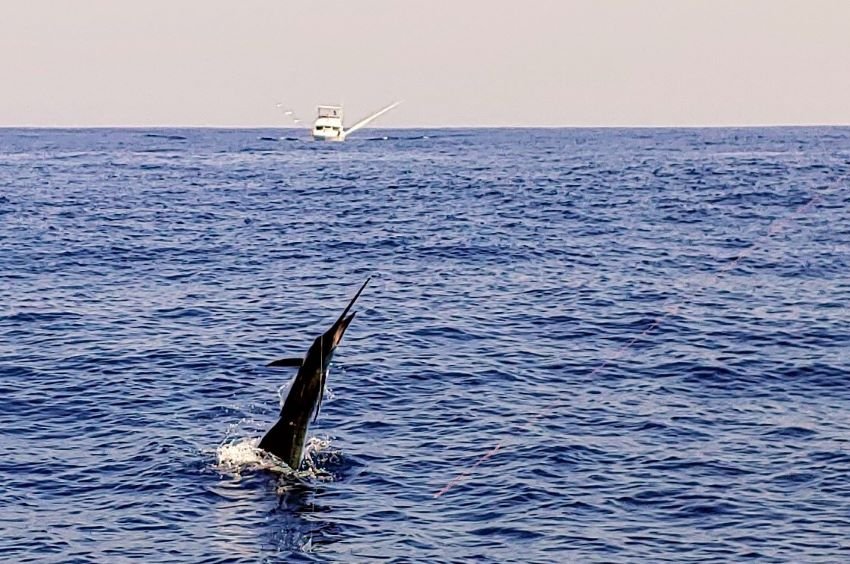How to Fish in a Crowd When You Were Supposed to Be “Getting Away From it All”
While prefishing for a tournament on the Potomac River eight Aprils ago, I found very little to go on, a fish here or there, with no consistency. When tournament morning rolled around I committed to fishing in what is perhaps the best-known and often hardest-hit area on the river. We were boat number 9 of 80, and while several boats ahead of us were headed that way, too, we passed them all at 74 miles per hour. When we arrived 15 miles later, we were the third boat in the bay, preceded only by two who had launched closer or earlier.
That wouldn’t last.
One after another, additional boats filtered in, sometimes in groups of two or three. By my unscientific count, at its peak there were 75 boats in an area the size of a few football fields. Most of them who stayed through the tidal cycle caught some fish. At times we were Power Poled down
At one point Hanna whispered, “Pete.”
“Speak up,” I replied loudly.
“Get the net,” she whispered through clenched teeth.
I figured it out, netted her 3-pounder, and only then did I realize how well she’d learned the game. She didn’t want to alert anyone not already in our vicinity that we’d potentially found a cluster of 15-inch-plus fish. Well done, grasshopper.
While Hanna caught a couple of bass on a Rat-L-Trap, we really started getting bit well when we transitioned to finesse tactics, specifically a Zoom Centipede on a Slider Head. I ended up 2nd in the tournament out of nearly 180 anglers, and Hanna was 11th.
I still don’t like fishing in crowds, but that day on the water reinforced that sometimes it’s an absolute necessity. Every time I perceive myself to be in that scenario, I think back to the lessons learned that day.
Why Does This Matter? Isn’t This a Travel Website?
Sure, the Potomac River is my home fishery, the one I visit most frequently. It’s also a popular and often-crowded venue in the midst of a major metropolitan area. Many of the trips we take – whether to El Salto, the Amazon, Panama or Guatemala – are decidedly more remote, although to different degrees. Nevertheless, we often find ourselves fishing in the local definition of a “crowd.”
At El Salto, that might mean that there are certain areas (often a particular flat or cove) where the fish are schooling, where the bait is stacked up, and/or where the water clarity is right. In our limited experience in Guatemala, water clarity and water temperature are critical, and the sailfish travel in packs, so as we’ve been fighting a double we’ve occasionally seen other nearby boats doing the same thing. In the Gulf of Chiriquí, there are certain key structural elements that draw in boats from all directions. In other words, there’s nothing in and of itself wrong with being around other boats. On the contrary, if often means that you’re around the best grouping of quality fish.
Unless you’re headed to an otherwise deserted atoll, or to some remote fly-in location, you’re probably going to be around other fishermen at some point during your trip, so it pays to be prepared.
Strategies for Fishing in a “Crowd”
First Rule of Fishing Around Others: Be respectful – If you consider it “combat fishing,” then you’re putting more energy into competing with your fellow anglers than you are into the process of getting the job done (i.e., catching fish). If you’re trolling and you go through someone else’s spread, or over their lines, it’s not cool, and the wasted time untangling that shit hurts everyone. In most scenarios there’s no hard-and-fast rule about proper distance you need to stay away, but recognizing the existing conditions, try to treat others the way you’d want to be treated.
Second Rule: Expect respect – I’ve seen screaming matches and fights on the water. I’ve heard of anglers and captains taking revenge on those who they feel have wronged them. While I understand the frustration and emotion, that sort of action rarely leads to the best outcomes. Instead, if possible, try to negotiate with others a proper division of the area, either through your actions (maintaining an appropriate distance) or through an even-toned discussion. If someone comes in on you inappropriately, try to explain the area you want to yourself, and why.
Third Rule: Focus on yourself, but pay attention to everyone else – If you’re constantly worried about encroaching anglers, and fighting them off, you’re going to miss details that will help you catch more fish. Always know what is going on at the end of your line or lines. At the same time, the proximity to everyone else gives you a window into how to improve your catches. Is the one guy catching the majority of the fish using finesse gear while the rest of you are utilizing Bubba tackle? There’s your hint. Is someone trolling faster than the rest of the fleet and seemingly doing better? Pay attention.
Fourth Rule: Counterpunch – Remember the lesson we learned at the Potomac, specifically that our catch rate went up when we went from power fishing to finesse fishing? You may also want to go the opposite direction – instead of throwing conventionally-sized lures, upgrade to a giant glide bait to tempt the biggest fish in the area. It applies everywhere, and to every kind of fishing, at least in theory. If everyone is trolling lures that look like dorado, the marlin may respond better to something different. There are times when the K.I.S.S. rule makes sense, but it never hurts to try something different.
Fifth Rule: Pressure affects the fish – An unmolested school or population of fish may continue to gather and feed as expected, but once the whir of multiple outboards and the ping of many depthfinders hits them, they may go a little haywire. That might require a move to alternate techniques, or it may adjust their positioning. I can think of several major Potomac tournaments where the winners have fished in noted community holes, but stayed to the far outside, or went far inside, away from the heaviest traffic.
Sixth Rule: Don’t call attention to yourself – Yes, the bent rod pattern is a real thing. If you catch several fish, or several big ones, expect boats to gravitate your way. Sometimes it’s purposeful and sometimes it’s subconscious, but it happens. Fortunately for me, Hanna learned that lesson early and knows to be quiet, but I cannot begin to count the times that I’ve been on the water and someone has made a show of catching fish – whooping and hollering, effectively cutting their own legs out from underneath them.
Seventh Rule: Keep hope alive – I get that it’s frustrating not to have your preferred area to yourself. It changes the way you fish and likely ends up splitting the spoils. Nevertheless, particularly when fishing is tough, if there are multiple boats in one area take it as a sign of confidence. If others are catching fish around you and you are not, take it as a sign that you’re in the right place but just need to dial it in. And if your guide or captain stays in a crowded area, unless there’s some independent evidence that he’s lazy or just trying to save on gas, recognize that he makes his living by putting customers on fish – he’s an expert and his expert decision is to fish among others.
Eighth Rule: Know When to bail – Knowing how long to stay among the masses is a tough decision, and an imperfect science. I know that I have on occasion left too early and I’ve probably stayed too long a bunch of times as well. When you’re dealing with a guide or captain, on his or her home waters, generally it pays to defer to their judgment on this matter. However, if you just can’t stand being around others, and the fishing is subpar, you can certainly ask whether there are other options. They might be waiting for a particular time of day, or a specific tidal phase, when the action turns on. Don’t imply that they don’t know what they’re doing, but there’s no harm in asking kindly. Again, they depend on happy customers to keep their business going (and tips flowing) so defer to their judgment – trust but verify.








